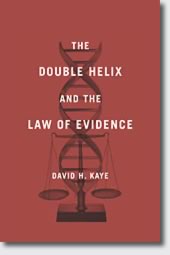 Whether entering a guilty verdict or predicting the end of a CSI episode, DNA evidence has given millions of people a sense of certainty—but the outcomes of using DNA evidence have often been far from certain, according to a new book The Double Helix and the Law of Evidence by Professor David Kaye of Penn State University.
Whether entering a guilty verdict or predicting the end of a CSI episode, DNA evidence has given millions of people a sense of certainty—but the outcomes of using DNA evidence have often been far from certain, according to a new book The Double Helix and the Law of Evidence by Professor David Kaye of Penn State University.
“There’s a popular perception that with DNA, you get results. You’re either guilty or innocent and the DNA speaks the truth. That goes too far. DNA is a tool. Perhaps in many cases it’s open and shut, in other cases it’s not. There’s ambiguity,” says Professor Kaye. Published by Harvard University Press, the book chronicles precedent-setting criminal trials, battles among factions of the scientific community, and a multitude of issues with the use of probability and statistics related to DNA.
From the O.J. Simpson trial to the search for the last Tsar, The Double Helix and the Law of Evidence covers the compelling story of how DNA science has impacted society. Professor Kaye delves into the history of the application of DNA science and probability within the legal system and depicts its advances and setbacks.
Anecdotes throughout the book contain lessons for lawyers and judges on using DNA science in court. “They don’t have to be research scientists. They don’t have to be technicians. But they do have to know enough to understand what’s going on and whether the statements experts are making are well-founded. The lawyers need to be able to translate that information into a form that a judge or a jury can understand,” explains Professor Kaye.
Professor Kaye also believes that lawyers need to better understand statistics and probability. Despite its significant role in the presentation of scientific evidence, it is an area that has traditionally been neglected in law school curriculum. The 352-page book attempts to close this gap in understanding with several sections on genetic science and probability.
Scientists, too, have contributed to the false sense of certainty, according to Professor Kaye, when they are so often led by either side of one particular case to take an extreme position. “Scientists need to approach their role as experts, not so much as partisans but as defenders of truth,” says Professor Kaye.
According to Professor Kaye, the important role that DNA science plays across a broad number of applications cannot be underestimated. “Death row exonerations have led people to think differently about the death penalty. People are talking about looking at Lincoln’s DNA to see if he had Marfan’s disease. You can use DNA to identify species to find out if what’s being sold as caviar is the real thing or to identify endangered species. And more applications are being considered every day,” says Professor Kaye.
For more, you can watch an interview with Professor Kaye on
YouTube and view his blog
Double Helix Law. The next issue of
The Dickinson Lawyer will feature an interview with Professor Kaye as well
.  Whether entering a guilty verdict or predicting the end of a CSI episode, DNA evidence has given millions of people a sense of certainty—but the outcomes of using DNA evidence have often been far from certain, according to a new book The Double Helix and the Law of Evidence by Professor David Kaye of Penn State University.
Whether entering a guilty verdict or predicting the end of a CSI episode, DNA evidence has given millions of people a sense of certainty—but the outcomes of using DNA evidence have often been far from certain, according to a new book The Double Helix and the Law of Evidence by Professor David Kaye of Penn State University.